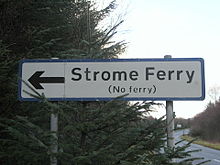Stromeferry
Stromeferry
| |
|---|---|
| OS grid reference | NG863344 |
| Council area | |
| Country | Scotland |
| Sovereign state | United Kingdom |
| Postcode district | IV53 8 |
| Police | Scotland |
| Fire | Scottish |
| Ambulance | Scottish |
Stromeferry (Scottish Gaelic: Port an t-Sròim) is a village, located on the south shore of the west coast sea loch, Loch Carron, in western Ross-shire, Scottish Highlands and is in the Scottish council area of Highland. Its name reflects its former role as the location of one of the many coastal ferry services which existed prior to the expansion of the road network in the 20th century.
It is served by Stromeferry railway station and is close to the A890 road. Stromeferry is on the southern bank of Loch Carron, Strome Castle is opposite on the northern bank.

The village is referred to in Iain Banks' novel Complicity, where the narrator describes the road sign marking the village, which states "Strome Ferry (No Ferry)".
The village has been subject of various development proposals focussing on the derelict hotel. In November 2007, W.A. Fairhurst & Partners, on behalf of the Helmsley Group, secured an outline planning consent for reinstating the hotel and building a number of new homes. This proposal should ensure that in the long term, new tourism and recreation opportunities will be secured in Stromeferry, and the village will once again play an important role in the local economy.
The Ferry
Stromeferry lies next to the narrowest part of Loch Carron and for many years, there was a ferry service here to North Strome. This provided a link with the first road built in 1809 along the north side of the loch[1]. Completion of the Stromeferry bypass (A890) along the south-eastern shore of the loch made the ferry service redundant and it ceased operating in 1970. At that time, there were two vessels providing the service. The larger of the two, 'Pride of Strome', measuring 16m long x 5m wide, was built in 1962 by Forbes of Sandhaven[2]. The smaller, 'Strome Castle', measuring 9m long x 3m wide, was built in 1958 by Nobles of Fraserburgh[3]. Both boats now lie wrecked on the shore of Loch Carron between North Strome and Lochcarron.
A temporary ferry service operated during October 2008 as loose rocks made local roads unsafe and alternative access was required during repair works. [4].
In January 2012, Highland Council chartered a boat to provide a temporary limited ferry service again following rockfalls closing the A890 road[5]. This was important in order to transport school pupils from the Lochcarron area to Plockton High School
Railway
Stromeferry was the original terminus of the Dingwall and Skye Railway opened in 1870 . Trains connected with steamer services from the pier to the islands of Skye, Lewis and mainland villages. The village expanded rapidly including the construction of a hotel serving rail and ferry passengers [6]. Following the extension to railway line to Kyle of Lochalsh which was completed in 1897 and provided a much shorter sea crossing to the islands, Stromeferry declined in importance.
Stromeferry Riot
Observance of the Sabbath was strong in the Highlands in the 19th century and the railway company's running of trains on Sundays considerable controversy among the local population. On 3rd June 1883, Stromeferry was the scene of a Sabbatarian riot in which over 200 fishermen took possession of the railway terminus to prevent the unloading of fish on a Sunday[7]. 10 men were imprisoned as a result[8]. The involvement of both police and military in breaking the riot was questioned in the House of Commons where it was stated that there was no law preventing Sunday traffic in Scotland[9].
References
- ^ "Ferry at Strome Ferry". Am Baile highland history and culture. Retrieved 13 January 2012.
- ^ "Historic Environment Record "Pride of Strome", Stromemore". The Highland Council. Retrieved 13 January 2012.
- ^
"Historic Environment Record Wreck of "Strome Castle" ferry, Strome". The Highland Council. Retrieved 13 January 2012.
{{cite web}}: horizontal tab character in|title=at position 29 (help) - ^ "Strome ferry boat". Am Baile highland history and culture. Retrieved 13 January 2012.
- ^ "Ferries set for introduction at Strome on Monday". Highland Council. Retrieved 13 January 2012.
- ^ "Strome Hotel, Strome Ferry". Am Baile highland history and culture. Retrieved 14 January 2012.
- ^ "Historical perspective for Stromeferry". The Gazetteer for Scotland.
- ^ MacColl, Allan W. (2006). Edinburgh University Press. ISBN 0748623825.
{{cite book}}: Missing or empty|title=(help); Text "Land, Faith and the Crofting Community:Christianity and Social Community in the Highlands of Scotland, 1843-1893" ignored (help) - ^ http://hansard.millbanksystems.com/commons/1883/aug/03/sunday-traffic-scotland-the-strome-ferry. Parliamentary Debates (Hansard). House of Commons. August 3, 1883. col. 1482.
{{cite book}}:|chapter-url=missing title (help)
